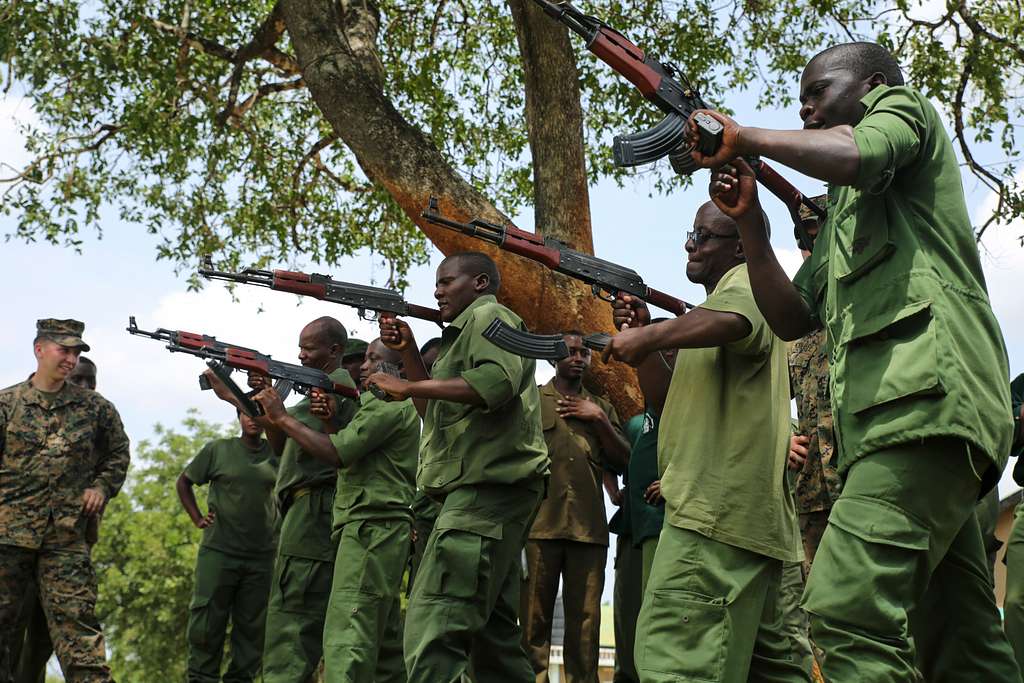Bullets and Biodiversity: African National Parks as a Key Counterterrorism Strategy
How can African governments and the international community respond to the threats posed by armed groups in African national parks?

Published by The Lawfare Institute
in Cooperation With

On June 19, at least 41 children and locals were killed in an armed attack at a school in Uganda. Shortly after the attack, law enforcement chased the fleeing perpetrators—the Allied Democratic Forces (ADF)—toward Virunga National Park in the Democratic Republic of the Congo (DRC). The Ugandan government even deployed planes during the search but was unable to find the perpetrators, which is unsurprising considering that the ADF is known for its ability to lie low in civilian communities without attracting law enforcement. The ADF—a key Islamic State affiliate also referred to as the Islamic State Central African Province—is just one of the nearly 100 armed groups that operate within the DRC.
The ADF, and groups like it, have been known to take refuge from law enforcement in Africa’s national parks. The parks provide immense operational security and financial opportunities for armed groups and designated terrorist groups, making it easier for them to carry out illicit activities. To combat this, African governments often rely on park rangers (and their unrelenting devotion to the parks) to fight off poachers and these armed groups. Despite their efforts, these rangers rarely receive adequate training and equipment to effectively take on armed groups. To better understand the African militant threat landscape, policymakers and counterterrorism scholars must consider the largely unaddressed vulnerability of national parks on the continent.
The Perfect Hiding Place
The dense jungles of Virunga National Park and its surrounding villages are home to nearly 5 million people who, unfortunately, are not strangers to conflict. The population of the villages and 1.8 million acre park is facing an uphill battle, as guards are vastly outnumbered by armed groups, making it the perfect hiding place to carry out illicit activities. Caught in a battle between opposition rebel groups and government forces, Congolese civilians have frequently had to adapt to the ongoing conflict that has led to the pillaging of their homes, villages, and national parks. At least 520,000 civilians had to flee their homes as a result of renewed fighting between federal forces and various rebel groups.
However, this problem is not confined to Virunga. Throughout West Africa, armed groups take advantage of national parks’ relative isolation to obtain operational security. In W National Park—which is situated along the borders of Benin, Burkina Faso, and Niger—jihadist groups under the Jama’at Nusrat al-Islam wal-Muslimin (JNIM) umbrella recruit and enlist locals into their ranks. They generally prey on bandits and young men with troubled pasts from the surrounding villages. These armed groups make far-fetched promises to return pastoral land to farmers, herders, and fishermen—whose lands were originally taken by the federal government for conservation. In exchange, the pastoralists are expected to support the jihadists’ dominion over the bushland.
Another way armed groups take advantage of locals and bushland herders in villages across Africa is by promising them open access to the parks’ vast grasslands for agricultural use. When the pastoralists accept the armed groups’ offers and begin to populate the parks, the farmers’ civilian presence deters federal military forces from taking action in the parks against armed groups. Given the parks’ low security measures, this approach has created the perfect system for armed groups to conduct covert operations and expand their network.
Illegal Exploitation and Threats to Rangers
The parks in West Africa are filled with rich natural resources, including a robust fishing industry, dense bushlands, and a sizable endangered animal population. Armed groups occupying national parks exploit these resources by manipulating civilians into giving up their land, which—combined with illicit practices related to poaching, fishing, and charcoal production—generates millions of dollars in revenue per year. Fishing, for example, is estimated to bring in approximately $100,000 a month for some groups through an illegal taxation system that armed groups use to charge locals for the use of canoes in certain areas. And armed groups are estimated to bring in nearly $1.7 million in revenue per month through charcoal burning.
In 2022, African rhino horn prices were estimated to be approximately $20,000/kilogram, and elephant ivory was sold for approximately $3,300/pound. Most of these materials are not bought in West Africa, but in China. According to the Center for Strategic and International Studies, approximately 70 percent of the illegal wildlife poaching and seizures in West African national parks involves wildlife purchases en route to China, making the Chinese economy the prime consumer in the illegal poaching industry.
Between 2009 and 2015, the Elephant Action League estimated that up to 188,170 kilograms of ivory were smuggled by al-Shabaab through just one prominent port in Kenya. Groups such as Darfur's Janjaweed (now known as the Rapid Support Forces) and Uganda's Lord's Resistance Army of Joseph Kony have also benefited from similar sales in the illegal wildlife trade. And all of these groups are further incentivized by record-high ivory prices in the international market.
In addition to exploiting wildlife, armed groups also target park rangers. The multitude of attacks against park rangers sends compelling messages to local communities—demonstrating that armed groups have a monopoly on the parks’ resources and neutralizing many efforts toward grassroots ecological conservation. In late April 2022, 12 park rangers were killed in Virunga by the Democratic Forces for the Liberation of Rwanda, a Rwandan Hutu rebel group. Five rangers were also killed in February 2022 in Benin by individuals possibly affiliated with the Islamic State or al-Qaeda. These dangerous conditions, coupled with low pay and isolation from family, do not bode well for the future of the already dwindling ranger workforce.
The Path Forward
One way to prevent armed groups from threatening national parks would be to harden physical security measures using federal resources. Many African federal governments have staffed parks with military personnel and ranking officers to defend the parks and preserve their biodiversity. However, this solution is not without its risks. Government officials and federal militaries in charge of protecting national parks have a long history of corrupting and illegally exploiting the parks’ vulnerabilities.
For example, between 1970 and 1980 on the border of Mozambique and Zimbabwe (modern-day Chimanimani National Park), the Military Intelligence Directorate of South Africa secretly financed the Selous Scouts, a Rhodesian paramilitary unit known for inciting violent civilian attacks. Instead of protecting the land, South African military officials profited from a barter system that they established with the Selous Scouts. Under this system, the armed group would pay the officials in elephant ivory in exchange for those officials turning a blind eye to the illegal ivory trade that the Selous Scouts established in the park.
Former Sudanese President Omar al-Bashir serves as another prominent example of this exploitation. From the time Bashir started his presidency in 1993 to his fall from power in 2019, Bashir was in direct control of a militia group known as the Sudan Armed Forces, which later became the Janjaweed. During Bashir’s leadership, the Janjaweed traded illegally poached ivory for arms, sustaining the group’s financial and weaponry needs. In fact, in Bouba Ndjida National Park in Cameroon, authorities believed that up to 450 elephants were killed by the Janjaweed in January 2013.
While there is a clear pattern of exploitation and corruption in the parks—seemingly regardless of who controls them—I do not mean to imply that every government or federally funded military group that works to secure the national parks funds armed groups through resource exploitation. Far from it. It is important, however, to highlight the potential consequences of this solution for policymakers and encourage the consideration of alternative paths.
A more viable solution is to provide park rangers with adequate training and weaponry to defend themselves and the parks against armed groups. And while some rangers’ salaries are paid by federal governments, this funding is lacking. For example, South African rangers are paid 246, 298 South African Rand, approximately $13,000 annually. Compared to the 287,784 South African Rand annual average salary ($14,909), rangers are significantly under-compensated—given the arduous and highly dangerous nature of their work.
These park rangers live on the base and establish intimate connections with the animals with whom they share the land. The deep ecological, social, and cultural relationships humans have developed with these animals are essential to the species’ survival and growth in these fraught situations. As dedicated keepers of the parks, rangers are less likely to join the poaching trade because of the pride that many rangers feel for their work. As opposed to government military soldiers or mercenary groups with little or no personal connection to the land, park rangers often foster deep, meaningful connections to the land they care for and the wildlife within.
In addition to their attachment to the parks, rangers’ extensive knowledge of the terrain gives them a comparative advantage against poaching and armed groups. Most rangers live in or near the parks. This provides them with intimate knowledge of the physical geography and cultural norms of the parks—enabling rangers to learn to adapt more quickly to the emerging threats of armed groups.
Park rangers are the first line of defense for the land. To make effective and sustainable counterterrorism efforts possible in these areas, providing funding for a sufficient number of rangers and arming them with the appropriate tools, weapons, and combat skills is imperative.
It is essential to consider the value of organizations that provide combat lessons to African park rangers, such as the Conservation Rangers Operations Worldwide, a volunteer-based organization that has provided free training and equipment to rangers since 2007. Survey results taken from 12 African countries reveal that nearly 59 percent of rangers do not have basic supplies and that 42 percent of those sampled do not have proper training. International aid contributions should focus on building a robust army of rangers to combat the illegal wildlife trade.
African national parks are expensive to maintain—with estimates showing that conservation funds in protected areas for lions fall $0.9 to $2.1 billion short of what is needed to sustain the population. In Gabon, the government has agreed to supplement rangers with military presence if staffing were to be considered “dangerously low.” However, the Gabonese government has never found it necessary to implement this fail-safe—despite Gabon’s poaching crisis and the lack of rangers to manage it. Why not?
There is simply not enough money to go around, even for the most essential spending. Gabonese park rangers have accused the government of paying them months late and not providing medical insurance due to lack of funds. If African governments cannot pay their rangers properly, what is the likelihood that these same governments will dramatically increase training for rangers and their supply of weapons? Additionally, as described above, federal governments’ control over the security of national parks can foster corruption—which could become worse if these governments were to establish an even tighter grip on the parks.
Optimizing International Aid
Therefore, international support for rangers will be critical. The prudent path toward more effective international spending on the protection of African national parks must begin with a structural shift in the distribution of this aid: from an ad hoc one to fortifying the domestic forces already in place, enabling them to operate independently and effectively in the long term.
The current international aid framework highlights counterterrorism and anti-poaching measures for conservation. What international aid fails to adequately consider is the protection and support of rangers as an integral part of the counter-extremism effort.
The Red Cross, for example, portrays Morocco’s hard-power counterterrorism strategy as a model for West African terrorism. But the Middle Eastern and North African (MENA) terrorism landscape looks vastly different from that of West Africa—partially because of West Africa’s many national parks with conservation needs. Advocating for Moroccan hard-power aid tactics in West Africa fails to acknowledge that different counterterrorism goals and tactics must apply to different regions. Without accounting for the terrorism breeding grounds that have come to define African national parks, the need for ranger resources, and wildlife conservation exigencies, the implementation of a comprehensive and sustainable counterterrorism strategy in West Africa is very unlikely.
Furthermore, the Wildlife Justice Commission (WJC), based in the Hague, has created a tactical intelligence and operations unit to support ongoing investigations of wildlife crimes. They have even published a “Map of Facts,” which is used to identify and document violators of wildlife protection measures. Because it was not established by an international treaty, however, the WJC is not a law enforcement agency and can make progress only through diplomatic negotiations. WJC’s lack of presence on the ground severely limits its ability to provide resources to rangers and meaningfully bolster the local counterterrorism infrastructure.
A far more diverse strategy deserves implementation: one where increased diplomacy, cooperation between public and private sectors, and the redistribution of aid from militancy to ranger resources are mutually implemented.
This aid could come in the form of training, weapons donations, or technical education. For example, the U.S. Park Service implemented a program in South Africa to discuss ranger shortages and technologies that can be used to reduce strain on rangers—“including drones, sound coordinating equipment and canine tactical deployments.” Additionally, the United States and South African officials discussed collaboration on tactical strategies and safety in the future. The United Kingdom also implemented a tactical operations program, sending seven soldiers to Liwonde National Park in 2017. The British soldiers gave Malawian rangers a crash course in information analysis, tracking people and animals, infantry strategies, and bushcraft. The establishment of similar programs would enable African governments to strengthen their existing workforce and support local community-building efforts in national parks instead of relying as heavily on international aid that does not account for the situation on the ground.
Conclusion
Terrorist financing and ecoterrorism threaten African security, which is reason enough to think seriously about solutions to the dangers—like insecurity at the national parks—that underlie these intractable issues. To make counterterrorism efforts possible in these areas, arming park rangers with the appropriate tools, weapons, numbers, and combat skills is critical. In addition, it is important to recognize the double-edged sword that is federal involvement in national parks. Finding a way to neutralize the threats of corruption and ivory for arms trading is essential to combat terrorism in these lands. International aid that meaningfully accounts for the local necessities of African national parks is the right starting place. In the current political environment, it is easy to design Africa’s international narrative simply around conservation, but it is not only wildlife that is at stake—so too is the livelihood and safety of future generations that call these national parks home.




